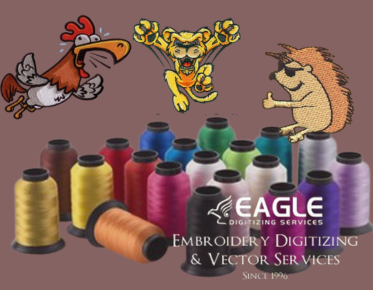How to Adjust Digitizing Settings Based on Fabric Type – A Quick Guide
Embroidery digitizing is a crucial process that transforms artwork into a stitch file, which can be read by an embroidery machine. This process is essential for achieving high-quality embroidery results, especially when dealing with different types of fabrics. Understanding how to adjust digitizing settings based on fabric type can significantly enhance the quality of your embroidery projects.
Understanding Fabric Types
Fabrics come in a wide variety of textures, weights, and compositions, each requiring specific adjustments in digitizing settings. Common fabric types include cotton, polyester, silk, denim, and leather. Each of these materials reacts differently to embroidery, necessitating unique approaches to digitizing.
Cotton
Cotton is a versatile and widely used fabric in embroidery. It is relatively easy to work with due to its smooth texture and moderate weight. When digitizing for cotton, ensure that the stitch density is balanced to prevent puckering. A medium stitch length is often ideal for maintaining the fabric's integrity.
Polyester
Polyester is known for its durability and resistance to wrinkles and shrinking. However, it can be challenging to embroider due to its slippery nature. When digitizing for polyester, increase the underlay stitches to provide a stable base for the top stitches. This helps in reducing the movement of the fabric during embroidery.
Silk
Silk is a delicate fabric that requires careful handling during embroidery. Its smooth and shiny surface can easily show imperfections. When digitizing for silk, use a lower stitch density and finer needles to avoid damaging the fabric. Additionally, consider using a stabilizer to support the fabric during the embroidery process.
Denim
Denim is a heavy fabric that can handle dense embroidery designs. When digitizing for denim, increase the stitch density and use thicker threads to ensure the design stands out. It's also important to adjust the tension settings on the embroidery machine to accommodate the fabric's thickness.
Leather
Leather is a unique material that requires special attention during embroidery. It is essential to use a leather needle and adjust the stitch length to prevent perforating the material. When digitizing for leather, reduce the stitch density and use a longer stitch length to maintain the fabric's integrity.
Digitizing Techniques for Different Fabrics
Each fabric type demands specific digitizing techniques to achieve the best results. For instance, when working with embroidery digitizing on silk, it is crucial to use a light underlay to prevent the fabric from showing through the stitches. On the other hand, denim requires a heavier underlay to support the dense stitches.
Choosing the Right Stabilizer
Stabilizers play a vital role in embroidery, providing the necessary support to the fabric during the stitching process. The choice of stabilizer depends on the fabric type and the complexity of the design. For lightweight fabrics like silk, a tear-away stabilizer is often sufficient. In contrast, heavier fabrics like denim may require a cut-away stabilizer for added support.
Working with Eagle Digitizing
Eagle Digitizing offers professional embroidery digitizing services that cater to various fabric types. With over 25 years of experience, they provide high-quality digitizing solutions that ensure smooth sew-outs and minimize thread breakage. Their skilled digitizers are adept at adjusting settings to suit different fabrics, ensuring that each design is executed flawlessly.
Practical Tips for Successful Embroidery
To achieve the best results in embroidery, it is essential to test the digitized design on a fabric swatch before proceeding with the final project. This allows for any necessary adjustments to be made to the digitizing settings. Additionally, maintaining the embroidery machine and using high-quality threads can significantly impact the final outcome.
Exploring Advanced Digitizing Techniques
As technology advances, new digitizing techniques continue to emerge, offering exciting possibilities for embroidery enthusiasts. Techniques such as 3D puff embroidery and chenille embroidery can add depth and texture to designs, making them stand out. Staying updated with the latest trends and techniques can enhance your embroidery projects and keep them fresh and innovative.
Future Trends in Embroidery Digitizing
The future of embroidery digitizing is bright, with advancements in software and technology paving the way for more intricate and detailed designs. As digitizing software becomes more sophisticated, the ability to create complex patterns with ease will become more accessible. This evolution will likely lead to a surge in creativity and innovation within the embroidery industry.
In conclusion, understanding how to adjust digitizing settings based on fabric type is crucial for achieving high-quality embroidery results. By considering the unique characteristics of each fabric and employing the appropriate digitizing techniques, you can ensure that your embroidery projects are both beautiful and durable. Whether you're a seasoned professional or a hobbyist, staying informed about the latest trends and techniques in embroidery digitizing will help you continue to create stunning designs.



